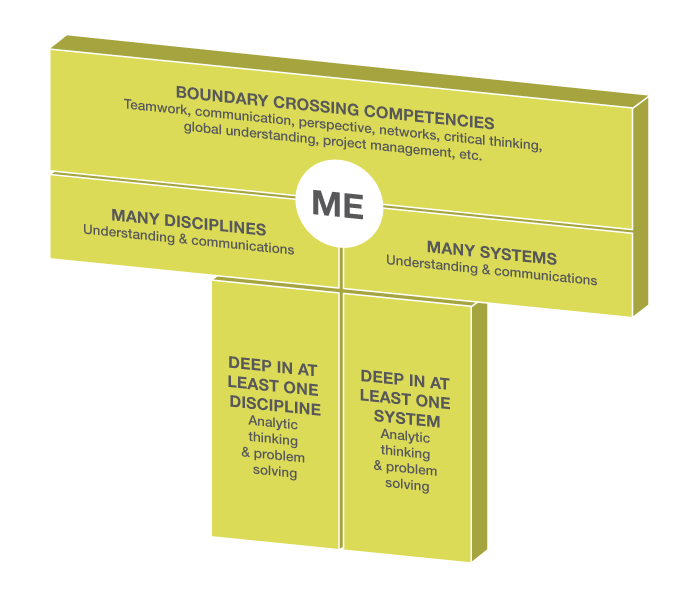From tech-savvy to digitally literate: the era of the T-shaped graduate
It is almost taken for granted that students studying at creative media institutions have a greater cognitive disposition to be, or quickly become, digitally literate. It is not so difficult to comprehend why some have this view. Studying in technical and resource-intensive creative media disciplines such as Film Making, Audio Production and Games Development, can only be undertaken with state-of-the-art camera equipment, coding, large consoles such as mixing desks, and software from Da Vinci Resolve to Pro Tools.
Digital literacy refers to the ability to create, access and use information (Gilster, 1997). It’s about combining a broad range of digital and critical thinking skills to be able to effectively use digital devices to make sense of the world and how it is changing (Eshet-Alkalai, 2004). Digital literacy goes beyond the ability to use a specific software, which is often relied upon as an indicator of digital literacy. With digital literacy becoming increasingly valued in industry, we must look at how institutions are equipping students to become digitally literate. Just because students these days are seen as tech-savvy, it can’t be automatically assumed they are digitally literate.
Digital literacy and ‘T’ shaped graduate
The era of the ‘T’ shaped graduate is here, where a graduate possesses a depth of competencies cutting across boundaries in a range of areas, as shown in the figure below. Industry trends indicate that graduates are increasingly being required to possess a multitude of skills in addition to their subject specific skills. An exciting example of this is where post-production between film and audio seems to be integrating – graduates will be required to have skills in both because of pressures to release products and complete work ever more speedily to satisfy clients.
Increasingly complex challenges faced by employers means that they need graduates who are creative and critical thinkers who possess skills not just in one discipline, but many. It is this interdisciplinary thinking that encourages much needed fresh perspectives.
(T Academy, 2018)
Are creative media students advantaged when it comes to digital literacy?
While observing live teaching sessions with students in the UK, I found excellent examples of students learning to use technology; whether this be through deconstructing videos to explore the realms of diegetic music in movies or the use of post-production software. Creative media students would be typically classed as advanced users, as opposed to basic or intermediate users, as they utilise software and technology for a specific purpose or career (Johnson et al., 2002). In contrast, basic users only make use of technology through more mainstream services such as social media networks. Compared to other disciplines, one could say that creative disciplines are well-positioned to embed Technology Enhanced Learning (TEL), another popular term synonymous with digital literacy, in the curriculum due to the extensive use of technology.
The Navitas Student Technology Survey further reveals that students are connecting more with technology in their learning. The survey found that 93% of students accessed information using their smartphone and the most common reasons for using their smartphone included finding information (63%) and managing group work (46%).
It is taken for granted that just because new generations of young people live in an online world of connectivity, that somehow, they would be digital natives and therefore digitally literate (Prensky, 2001). This presupposition also applies for creative media graduates; creative media students may be advanced users of technology, but not necessarily advantaged when it comes to being digitally literate.
The SAE digital literacy revalidation
Further informed by an Industry Advisory Council, SAE is currently undertaking a large-scale revalidation effort across four regions (the UK and three overseas regions), involving over 20 campuses. The revalidation includes producing a concept of ideas for the curriculum of the future. It will answer critical questions such as:
- What jobs will exist in the future?
- What skills will our graduates need?
- What type of assessment will simulate learning in an authentic environment?
- Which systems will we need to support the delivery of an innovative curriculum and track student engagement?
There is no doubt that creative media institutions play a significant role in equipping the next generation of graduates for a sector that far outstrips many others, contributing £92bn to the economy (Creative Industries Council, 2018). I argue that creative media institutions can benefit from taking both a bottom up approach to digital literacy, and a top down approach to integrated curriculum with industry insights. This will ensure that graduates are adequately prepared with the portfolio of digital skills required to keep up with industry demands.
To continue the conversation, contact Saad Qureshi or share your thoughts and ideas about digital literacy via Yammer, Twitter and/or LinkedIn with the hashtag #edtech.
References
- Anderson, D. M. (2013). Overarching goals, values, and assumptions of integrated curriculum design. SCHOLE: A Journal of Leisure Studies and Recreation Education, 28(1), 1-10.
- Belisle, C. (2006). Literacy and the digital knowledge revolution. In A. Martin & D. Madigan, Digital literacies for learning (pp. 51-67), London: Facet Publishing.
- Creative Industries Council. (2018). Facts and figures. Retrieved from http://www.thecreativeindustries.co.uk/uk-creative-overview/facts-and-figures.
- Eshet-Alkalai, Y. (2004). Digital literacy: A conceptual framework for survival skills in the digital era. Journal of Educational Multimedia and Hypermedia, 13(1), 93-106.
- Gilster, P. (1997), Digital literacy. New York: Wiley Computer Publications.
- Johnson, R., Edmundson-Bird, D. & Keegan, B. (2012). Making digital literacy a success in taught marketing courses. Enhancing Learning in the Social Sciences, 4(2), 1-15.
- Prensky, M. (2001). Digital natives, digital immigrants. On the Horizon, 9(5).
- Prensky, M. (2004). The emerging online life of the digital native: What they do differently because of technology, and how they do it. Retrieved from http://www.marcprensky.com/writing/Prensky-The_Emerging_Online_Life_of_the_Digital_Native-03.pdf.
- T Academy (2018). What is the “T”?. Retrieved from http://tsummit.org/t.

